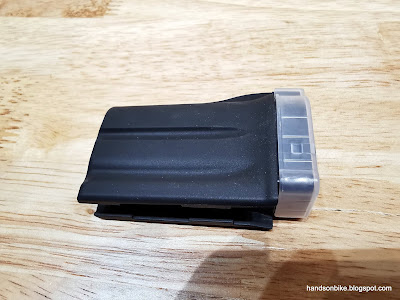Both Shimano and SRAM have their own electronic shifting drivetrains, and with that, batteries are required. Shimano has both internal and external batteries for their Di2 systems, while SRAM has only external batteries for its eTap and AXS systems.
Since I have both electronic systems, I wanted to do a comparison showing the differences in the batteries and also the battery chargers.
The Fnhon folding bike started with an 11 speed Shimano Di2 system, and was recently changed to a 12 speed SRAM AXS system. For details about how the systems were set up, refer to the Fnhon DB11/12 folding bike page.
The biggest difference between these systems is that the Shimano battery is wired to all the shifters and derailleurs, and powers all of these components with a single central battery. On the other hand, the SRAM system is wireless, and thus each derailleur requires its own battery. The SRAM shifters have their own coin battery as well.
SRAM eTap battery! Had to get it from a local shop as batteries can't be bought online.
7.4 volts and 300 mAh capacity. Lots of regulatory symbols!
Shimano Di2 battery has a larger capacity of 500 mAh, while the voltage is the same at 7.4 volts.
SRAM battery has its own battery cover for protection, when the battery is removed from the bike during transportation to avoid unintended battery drain.
Interestingly, the red cover has a switch that you can set to indicate whether this battery has a full charge or not.
Shimano Di2 battery has a transparent cover, but this is rarely used as you can leave the battery on the bike during transportation.
Side by side size comparison shows that the Shimano Di2 battery is much larger.
It is quite a lot larger, about 2 to 3 times larger by volume.
Difference in contact points. The Di2 battery plugs into the battery mount, while the eTap battery plugs to the derailleurs.
Shimano Di2 battery weighs 71 grams.
SRAM battery is a lot lighter at just 24 grams. Easy to carry a spare if you are worried about running out of juice.
Shimano Di2 battery is charged using a battery charger which is rather big in size.
Insert the battery, and the LED will show that it is being charged. The LED turns off when the battery is full.
SRAM battery charger, sold separately from the battery and other components.
This charger is a lot smaller in size.
LEDs show the charging status.
Size comparison of the battery chargers. The SRAM charger is much more compact in size.
Indicator lights on the chargers when the batteries are being charged.
In conclusion, the SRAM battery is smaller, but you need two of them if you run both a rear and front derailleur. Also, the SRAM system has a shorter run time, as the wireless protocol requires more power compared to the Shimano wired system.
On the other hand, the small SRAM battery makes it easy to carry a spare, or swap the front and rear battery if one of them runs out of juice.
Each system has its own pros and cons, although I am leaning towards the wireless system by SRAM which makes it super easy to set up, since no wire routing is required.


















No comments:
Post a Comment
Every comment is moderated before publishing due to spam bots. If you don't see your comment yet, it is likely that it is currently being reviewed. Thank you for your patience!